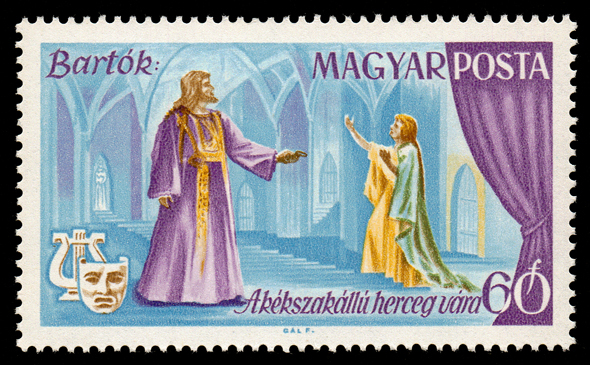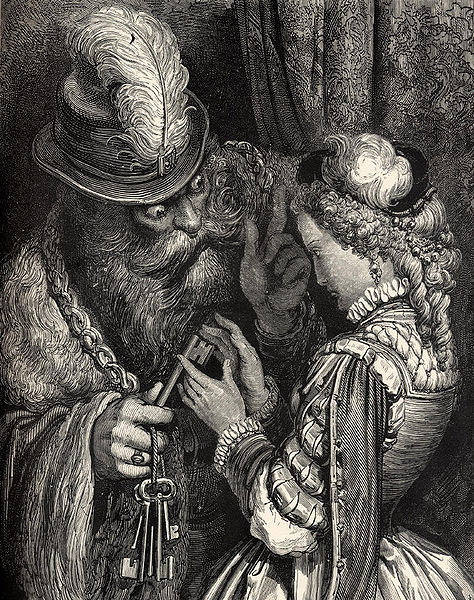Music with Ease > 20th Century Opera > Duke Bluebeard's Castle (by Bela Bartok)
Duke Bluebeard's Castle
(by Bela Bartok)
Opera in one act.
Written: 1911.
Premiere: 1918.
Libretto: Written by Bela Balaz. The libretto was an adaptation of Charles Perrault's 1697 story, Barbe Bleue. The style of the libretto was greatly influenced by Dukas' opera Ariane et Barbe-bleue (the latter's libretto was written by the Belgian symbolist writer, Maurice Maeterlinck).

A scene from Bartok's opera, Bluebeard's Castle, as depicted on a postage stamp issued by Hungary in 1967.
Plot
A short spoken prologue (by the Storyteller) tells the audience that they are entering a world of myth which may reveal something of the inner self.
Bluebeard and his new wife Judith enter Bluebeard's castle. The latter has just married Bluebeard despite her family's opposition. She is still in her wedding dress. She finds Bluebeard's castle "icy, dark and gloomy" and vows to brighten it up.
Judith notices seven mysterious doors and asks for the keys so that the doors can be unlocked. Bluebeard is reluctant to do give them to her, hints at unhappy events in his past, but finally does hand the keys to her.
Behind the first door she finds Bluebeard's torture chamber, complete with racks, branding irons and daggers. The chamber is bathed in a blood-red light.
Behind the second door she finds Bluebeard's armoury with bloodstained spears. The armoury is lit by a yellow-red light.
Behind the third door she finds Bluebeard's treasury, replete with gold, pearls and diamonds. These are all stained with spots of red.
Behind the fourth door she finds Bluebeard's garden. It is fragrant and contains white roses, but even these beautiful flowers are splattered in blood. Her husband refuses to explain the meaning of what she is seeing.
Behind the fifth door Judith discovers a vast and sunny kingdom. But here again the the clouds and the lands are colored blood red. Bluebeard warns Judith not to open any more doors. She has brightened the castle by opening the first five doors, but, he warns, to open more would just invite darkness.
Judith insists on continuing and behind the sixth door she finds a white-colored lake, a huge white sheet of water. "Tears, my Judith, tears, tears," he says. Judith asks him about his former wives and when he refuses to answer, she says that she thinks he killed them all.
Behind the seventh door are three beautiful women dressed in fine clothing. The women walk slowly out and, Bluebeard introduces them as his former wives. The first he met in morning, the second at midday, and the third in the evening, he relates. They return to their room. Bluebeard dresses Judith in fine clothing and crowns her "bride of the night". Terrified and pleading for her life, Judith passes through the seventh door. Bluebeard is left alone and in darkness.

Gustave Doré woodcut of Bluebeard and Judith in Pierre-Jules Hetzel's 1867 edition of Les Contes de Perrault (Perrault's Fairy Tales).
Study Notes
Duke Bluebeard's Castle is Bartok's one and only opera. Although the composer wrote it when he was just 30 years old, it is a truly mature work.
Bartok’s music was influenced by Romantic composers such as Richard Strauss and Franz Liszt and by impressionistic composers including Claude Debussy. In his youth Bartok made a close study of Hungarian folk music, elements of which are reflected in his work.
In this opera Duke Bluebeard’s Castle Bartok echoes the work of Debussy’s work (e.g. the chords for orchestra and organ at the opening of the fifth door reflect parts of La cathedrale engloutie) and Richard Strauss’s Ein Heldleben.
In addition, both the harmonies and the melodies of the opera echo the unusual modal scales, the decorated first beat and the parlato rubato commonly found in Hungarian folk music.
The opera’s imagery features a strong red color (suggesting expressionism or symbolism). Other elements (e.g. blood, flowers, etc.) suggest influences from Jugendstil (German art nouveau).
The libretto was based on Maurice Maeterlinck’s symbolist play Ariane et Barbe-bleue (Ariane and Bluebeard) and Bartok’s music also echo elements of that play. The score and the libretto are built around an underlying symbolism with themes of darkness vs themes of light and with each character (Bluebeard, Judith) being associated with certain music notes and keys.
The theme associated with blood (an interval of a minor second) is played each time one of the doors is opened. A different and expressive tone poem is played each time one of the room interiors is explored.
A key moment occurs when the fifth door opens and a huge chord is played by the orchestra and organ. The music here suggests that something decisive has happened and that the destiny of Judith is sealed.
Share this page:
Author: David Paul Wagner
(David Paul Wagner on Google+)
Music With Ease | About Us | Contact Us | Privacy | Sitemap | Copyright | Terms of Use © 2005-25 musicwithease.com. All Rights Reserved. |
